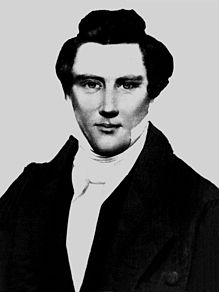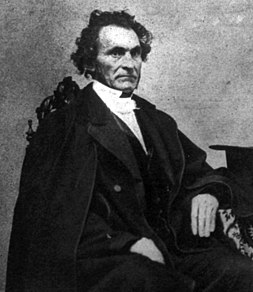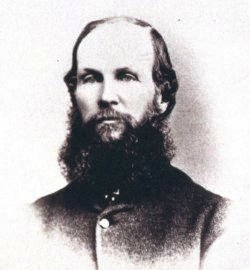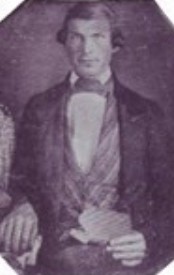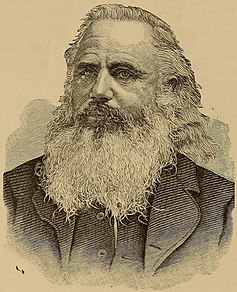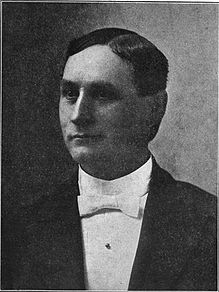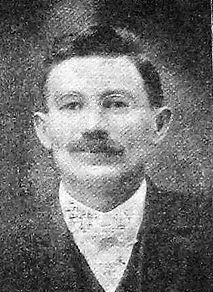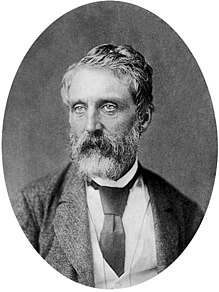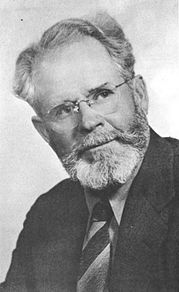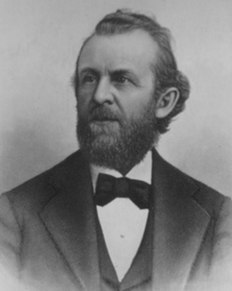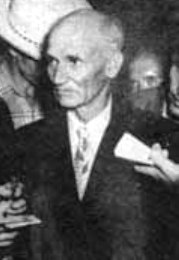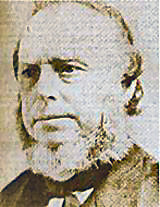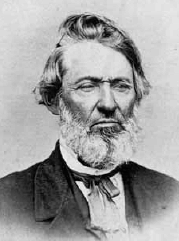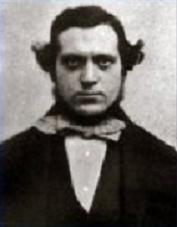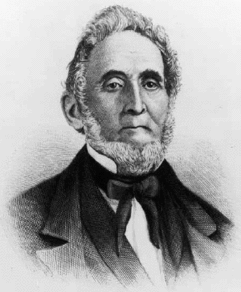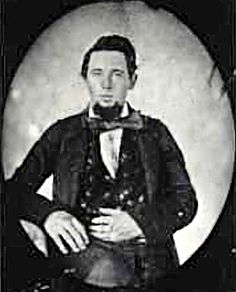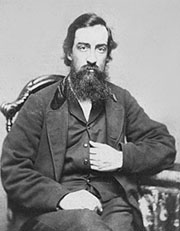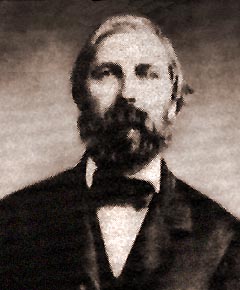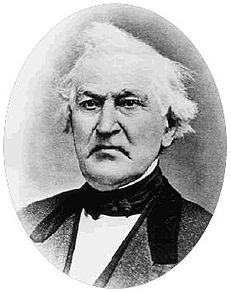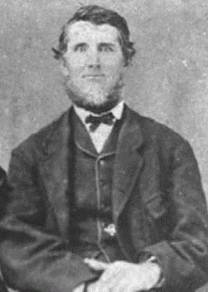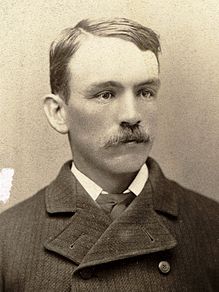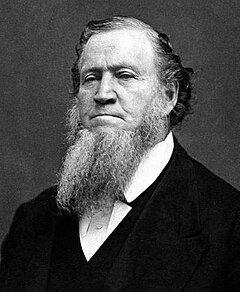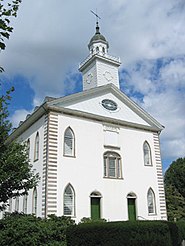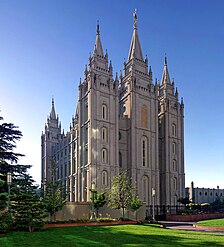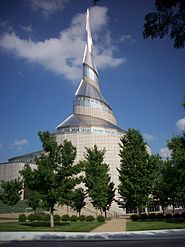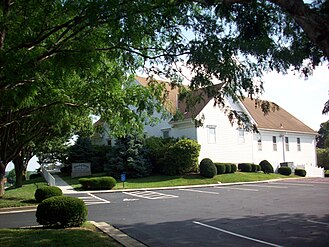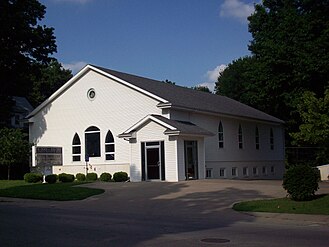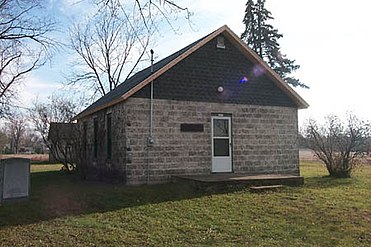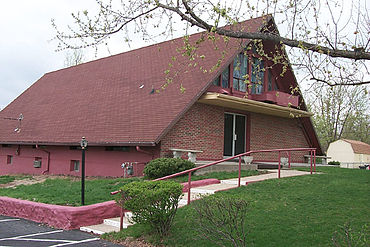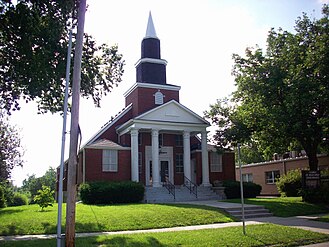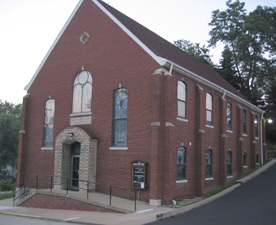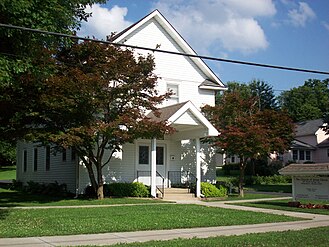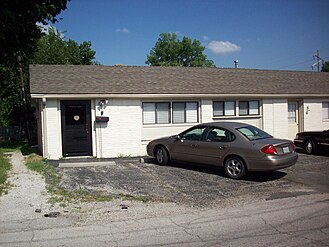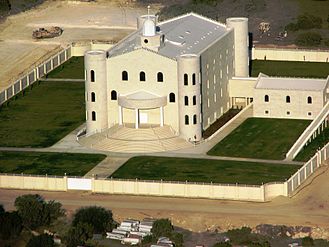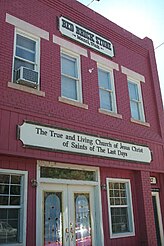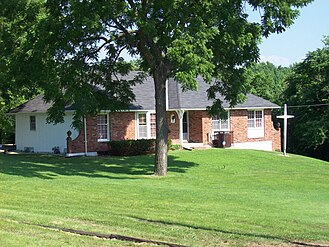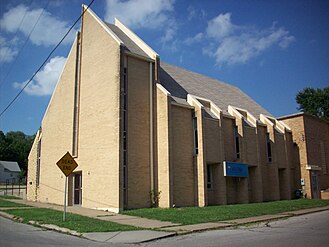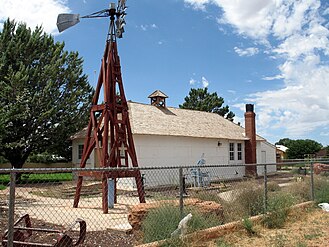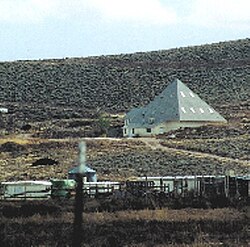List of denominations in the Latter Day Saint movement
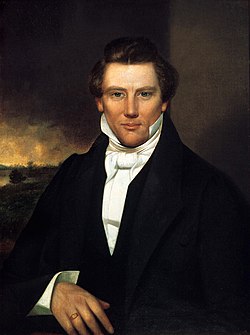
The denominations in the Latter Day Saint movement are sometimes collectively referred to as Mormonism. One source estimated over 400 denominations have sprung from founder Joseph Smith's original movement.[1] Mormon is an informal term used especially when referring to the largest Latter Day Saint denomination, the Church of Jesus Christ of Latter-day Saints (LDS Church), and other offshoots in the movement. Groups opposed to the use of the term Mormon such as the LDS Church consider it to be connected to the polygamy once practiced by the Utah church,[2][3] or to pejoratives used against early adherents of the movement.[4][5]
The Latter Day Saint movement includes:
- The original church within this movement, founded in April 1830 in New York by Joseph Smith, was the Church of Christ. It was later named the "Church of the Latter Day Saints". It was renamed the "Church of Jesus Christ of Latter Day Saints" in 1838 (stylized as the "Church of Jesus Christ of Latter-day Saints" in the United Kingdom),[6] which remained its official name until Smith's death in 1844. This organization subsequently splintered into several different denominations, each of which claims to be the legitimate continuation of this original church. Most of these dispute the right of other denominations within the movement to claim this distinction.
- The largest denomination within the contemporary movement is the Church of Jesus Christ of Latter-Day Saints, with over 17 million members.[7] It is headquartered in Salt Lake City, Utah.
- The second-largest denomination is the Community of Christ (it was first named the "Reorganized Church of Jesus Christ of Latter Day Saints", which lasted from 1872 to 2001). This is a Missouri-based, 250,000-member denomination. Although members of this church have traditionally been called Latter Day Saints (without the hyphen), the Community of Christ has more recently stated that it rejects the use of the term Saints as a designation for its members in any official reference or publication.[8]
- The largest groups of Mormon fundamentalism include the Fundamentalist Church of Jesus Christ of Latter Day Saints (FLDS), Centennial Park Group (The Work), Apostolic United Brethren (AUB or Allred Group), and Latter Day Church of Christ (DCCS or Kingston Group).[9]
- Other denominations within the movement either formed around various would-be successors to Smith, or else broke from denominations that did. These, together with the denominations listed above, are detailed in the table of denominations within the Latter Day Saint movement below.
Although a few small factions broke with Smith's organization during his lifetime, he retained the allegiance of the vast majority of Latter Day Saints until his death in June 1844. Following Smith's death, the movement underwent a leadership crisis which led to a schism within the church. The largest group followed Brigham Young and settled in what became the Utah Territory and is now the Utah-based LDS Church. The second-largest faction, Community of Christ, coalesced around Joseph Smith III, eldest son of Joseph Smith. Other would-be leaders included the senior surviving member of the First Presidency, Sidney Rigdon; the newly baptized James Strang from Wisconsin; and Alpheus Cutler, one of the Council of Fifty. Each of these men still retains a following as of 2014—however tiny it may be in some cases—and all of their organizations have undergone further schisms.[10][11][12] Other claimants, such as Granville Hedrick, William Bickerton, and Charles B. Thompson, later emerged to start still other factions, some of which have further subdivided.

Categorizing the churches
[edit]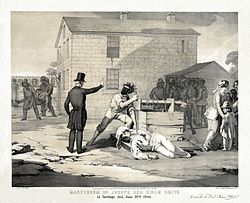
Given the large number of Latter Day Saint churches and their differing backgrounds, categorizing them can be difficult. In the field of Mormon studies, terms such as Rocky Mountain Saints are sometimes used for those denominations headquartered in the American West and Prairie Saints for those denominations that formed in and around Nauvoo, Illinois; Voree, Wisconsin; Independence, Missouri; and other locations in the Midwest and East. These terms do not necessarily relate the current geographical locations of all denominations within those two groupings, but rather the original location of their respective parent organizations, which may be seen in the table below.
Another method uses provenance: for instance, all denominations that ultimately trace their history back to the LDS Church based in Utah, are organized as one factional group. Divergent Paths of the Restoration—a reference work on this subject—follows this approach.[10]
In such studies, and in general Latter Day Saint parlance, the -ite-suffixed terms Josephite and Brighamite have been used for the Missouri-based Community of Christ and the Utah-based LDS Church, respectively; these terms have sometimes been used to distinguish groups of denominations as well. Those denominations within each group share a common ancestry and basic beliefs that are different from groups sharing other provenances. The present article, in a similar fashion, distinguishes among groups of denominations by use of commonly understood names such as Mormon fundamentalist or else by short descriptions that often reference a founder of the first church within a factional group–for example, Joseph Smith III in reference to Community of Christ as well as various churches and factions that trace their origin to it.
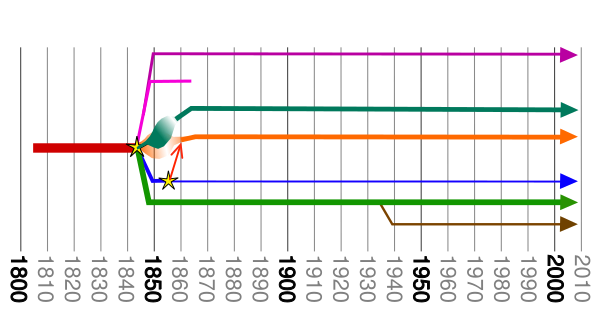
List of Latter Day Saint movement churches
[edit]
Era of Joseph Smith
[edit]Joseph Smith's original church,[10] and those bodies which broke with him during his lifetime.
Original church within movement
[edit]The original organization, founded by Joseph Smith in 1830, later called the Church of the Latter-Day Saints and then The Church of Jesus Christ of Latter-Day Saints.[13][14]
| Name | Organized by | Date | Current status | Notes |
|---|---|---|---|---|
| Church of Christ[10] | Joseph Smith | April 6, 1830 | Smith's original organization; multiple denominations currently claim to be its true successor | In 1834, official name changed to "Church of the Latter Day Saints". In 1838, official name changed again to "Church of Jesus Christ of Latter Day Saints".[13][14] Unofficial names included Church of God and Church of Jesus Christ.[15] |
Churches that separated from Smith's organization prior to 1844
[edit]Other small churches formed on the basis of disagreements with Smith prior to his murder in 1844 (including church established by William Law within 1844), all of which are now defunct.
| Church name | Organized by | Date | Split from | Current status | Notes |
|---|---|---|---|---|---|
| Pure Church of Christ[16] | Wycam Clark | 1831 | Church of Christ | Defunct | First schismatic denomination in the Latter Day Saint movement. |
| Independent Church[17] | – Hoton[18] | 1832 | Church of Christ | Defunct | Little is known about this second schismatic denomination apart from the date of establishment, the surname of its founder, and that Hoton denounced Joseph Smith and the Book of Mormon.[18] |
| Church of Christ[10] | Ezra Booth | 1836 | Church of the Latter Day Saints | Defunct | Taught that Joseph Smith was not a prophet, and the Book of Mormon was not scripture. |
| Church of Christ[19] | Warren Parrish | 1837 | Church of the Latter Day Saints | Defunct | Also referred to as the Church of Christ (Parrishite). Believed that Smith was a "fallen prophet". Rejected the Book of Mormon and parts of the Bible. |
| Alston Church[16] | Isaac Russell | 1839 | Church of Jesus Christ of Latter Day Saints | Defunct | Taught that the Latter Day Saints should remain in Missouri, and not emigrate to Illinois. |
| Church of Christ[10] | William Chubby | Late 1830s | Church of Jesus Christ of Latter Day Saints | Defunct | Established with the special mission of ministering to African Americans. |
| Church of Jesus Christ, the Bride, the Lamb's Wife[16] | George M. Hinkle | 1840 | Church of Jesus Christ of Latter Day Saints | Defunct | Taught that Smith was not a prophet, and the Book of Mormon was not scripture. |
| Church of Christ[10] | Hiram Page | 1842 | Church of Jesus Christ of Latter Day Saints | Defunct | Little is known concerning this denomination, except that its founder was one of the Eight Witnesses to the Book of Mormon's golden plates |
| True Church of Jesus Christ of Latter Day Saints[16] | William Law | 1844 | Church of Jesus Christ of Latter Day Saints | Defunct | Opposed plural marriage; published the Nauvoo Expositor. Charges levied against Smith over the destruction of this periodical led to his assassination. |
Lineage of Brigham Young
[edit]Sometimes called "Rocky Mountain Saints," "Brighamites," or "Mormons", tracing their leadership or influence through Brigham Young.
The Church of Jesus Christ of Latter-day Saints
[edit]The Church of Jesus Christ of Latter-day Saints is by far the largest and most well-known Latter Day Saint church. It is colloquially referred to as the "Mormon Church".[20] The Church prefers to be called by its full title or by the shorthand "Church of Jesus Christ" to emphasize its worship of Jesus Christ and to distance itself from the phrase "Mormon", which has derogatory origins.[21][22][23][24]
| Name | Organized by | Date | Continuation of\split from | Current status | Notes |
|---|---|---|---|---|---|
| The Church of Jesus Christ of Latter-day Saints[10][25] | Brigham Young and Quorum of the Twelve |
1844 (trust reorganized); 1851[26] (incorporated) |
Church of Jesus Christ of Latter Day Saints | 16.8 million members as of 2021[27] | The largest Latter Day Saint denomination. Headquartered in Salt Lake City, Utah. Often colloquially referred to as the Mormon Church. Adherents are popularly called Mormons or Latter-day Saints. Resulted from Latter Day Saints that followed Joseph Smith. Practiced plural marriage until it was discontinued in 1890. Disincorporated in 1877 by the Edmunds–Tucker Act, reorganized in 1923 as the Corporation of the President of The Church of Jesus Christ of Latter-day Saints |
Churches upholding polygamy after the Manifesto of 1890
[edit]
Churches that believe they are strictly following the revelations and teachings of Joseph Smith and Brigham Young, including the practice of plural marriage, which was discontinued by the LDS Church in the late-19th century after the Manifesto.
| Name | Organized by | Date | Split from | Current status | Notes |
|---|---|---|---|---|---|
| Council of Friends[28] | Lorin C. Woolley | 1920s | LDS Church | Multiple denominations claim to be true successor | Also known as the Priesthood Council, this group was originally headquartered in Salt Lake City, Utah, and the Short Creek Community. One of the earliest Mormon fundamentalist groups, originating at end of plural marriage in LDS Church. Later splintered into several groups, particularly upon death of Joseph W. Musser in 1954. Most modern Mormon fundamentalist groups may be traced back to this organization. |
| Latter Day Church of Christ[29] | Elden Kingston | 1935[29] | Council of Friends[28] | Roughly 5,000 members | Headquartered in Davis County, Utah. Commonly known as the "Davis County Cooperative Society". |
| El Reino de Dios en su Plenitud (The Kingdom of God in its Fulness)[30][31][32][33] | Margarito Bautista | 1947 | Remnants of the Third Convention that did not rejoin the Church in 1946 | About 800 members (2011)[34] | After being expelled from the Third Convention movement in 1937, Margarito Bautista made preparations to found a colonia as a religious utopian project.[34] Bautista and other former members of the Third Convention that did not join the mass reconciliation in 1946 founded Colonia Industrial in Ozumba, Mexico and established their own Mormon sect.[35] The sect, now known as El Reino de Dios en su Plenitud, remains extant, and it continues practicing economic communitarianism and plural marriage.[30][32] |
| Apostolic United Brethren[29] | Rulon C. Allred | 1954 | Council of Friends | Approximately 10,000 members (1998)[36] | Headquarters in Bluffdale, Utah. Organized during schism between two groups over issue of presiding authority between Rulon C. Allred and Leroy S. Johnson, upon death of Joseph W. Musser.[29] |
| Fundamentalist Church of Jesus Christ of Latter-Day Saints[29] | Leroy S. Johnson | 1954 | Council of Friends | 8,000–10,000 members[37] | Traditionally headquartered in Colorado City, Arizona, with a community of roughly 700 members near Eldorado, Texas. Also called "FLDS Church" and is the largest group of Latter Day Saints who practice plural marriage and Mormon fundamentalism. |
| Church of the Firstborn of the Fulness of Times[29] | Joel F. LeBaron | 1955 | Apostolic United Brethren[38] | Precise continuity unknown, several hundred or a thousand believers' following one or another putative successors to denomination leadership | Headquartered in Colonia Lebaron, Mexico[39] Established in northern Mexico and elsewhere, this group claims an especial priesthood keys owing to a line of authority through Benjamin F. Johnson, a member of the Council of Fifty. |
| Church of the Firstborn[40] | Ross Wesley LeBaron | 1955 | Church of the Firstborn of the Fulness of Times | A hundred or more | Originally headquartered in Salt Lake City, Utah. (Within months of the organization of the Church of the Firstborn of the Fulness of Times, Ross Wesley LeBaron broke with his brothers and formed his own denomination, calling it simply "The Church of the Firstborn". Wesley believed he was sent to prepare the way for the One Mighty and Strong, who would be "an Indian prophet".[41][42] Three notable early followers were Fred Collier (whose 100-plus membership clan live in Hanna, Utah and elsewhere[43]), Tom Green, and Robert Black.[40] |
| Church of Jesus Christ in Solemn Assembly[44][45] | Alex Joseph | 1974[45] | Apostolic United Brethren | Approximately 400 headquartered in Big Water, Utah | In conjunction with the Church of Jesus Christ in Solemn Assembly, Alex Joseph group created the Confederate Nations of Israel in 1977, a Hybrid church–political organization patterned after the Council of Fifty. Members can be from any religious denomination or atheist. Around one-quarter of members practice plural marriage. |
| Church of the First Born Lamb of God[29] | Ervil LeBaron | 1972 | Church of the Firstborn of the Fulness of Times | Current status unknown, may continue in LeBaron family in Los Molinos, Baja California | Ervil LeBaron split with his brother, Joel F. LeBaron in 1972. Ervil then ordered his brother Joel killed in 1972, and Apostolic United Brethren leader Rulon C. Allred killed in 1977. LeBaron was extradited to the United States and sentenced to life in prison where he died in 1981. |
| Church of the New Covenant in Christ[16] | John W. Bryant | 1975 | Apostolic United Brethren | Headquartered in Salem, Oregon | Previously called the "Church of Christ Patriarchal" and the "Evangelical Church of Christ". One of Bryant's estranged wives says Bryant converted temple ordinances into sexual rites and that he authorized a type of "free love" among the members. |
| Righteous Branch of the Church of Jesus Christ of Latter-day Saints[29] | Gerald Peterson, Sr. | 1978 | Apostolic United Brethren | Approximately 100-200 members. Headquartered in St. George, Utah. | This small group of about 100–200 people was founded by Gerald Peterson Sr. They claim Gerald Peterson Sr. was the rightful successor to Rulon C. Allred and Spencer W. Kimball. They claim Allred and others, including God and Jesus, visited Peterson, who held and exercised all priesthood responsibilities and keys. |
| Sons Ahman Israel[46] | David Israel | 1981 | Church of the New Covenant in Christ[citation needed] | Based in Cane Beds, Arizona.
The number of members is unknown. |
One of the lesser known Fundamentalist Groups, organized by David Israel (real name, Gilbert Clark) with members of the Apostolic United Brethren and members of John W. Bryant's Group.[47] One of David Israel's revelation repudiates the succession of Brigham Young and affirms the appointment of James J. Strang. Another states that John Bryant was by then fallen. |
| School of the Prophets[16][48] | Robert C. Crossfield | 1982 | The Church of Jesus Christ of Latter-day Saints | Headquartered in Salem, Utah | In 1968 Crossfield published the Book of Onias which, among other things, condemned many LDS Church leaders and was excommunicated in 1972.[49] Through associations, and initially well received, with Mormon fundamentalists in Creston, British Columbia, Canada, in 1982 Crossfield established his own "School of the Prophets", presided over by a President and six counselors.[49] Ron and Dan Lafferty, convicted of the 1984 murder of their brother's wife and infant daughter, served as counselors in the Provo, Utah, School of the Prophets in 1984.[48] |
| Centennial Park[29] | Marion Hammon and Alma Timpson |
1984 | Fundamentalist Church of Jesus Christ of Latter-Day Saints | Roughly 1,500 members[29] | Also known as the "Second Ward". Organized by group who broke from Leroy S. Johnson over questions regarding presiding authority.[29] |
| The Church of Jesus Christ of Latter-day Saints and the Kingdom of God[29][50] | Frank Naylor and Ivan Neilsen |
1990 | Centennial Park | 200–300 members. Headquartered in Bluffdale, Utah[51] | Also known as the "Naylor group" and the "Third Ward".[29] Organized by group who broke from Centennial Park over conflicts in the leadership of Alma Timpson. |
| True and Living Church of Jesus Christ of Saints of the Last Days[29] | James D. Harmston | 1994 | LDS Church | 300–500 members (2004)[52] Headquartered in Manti, Utah. | Also called "TLC Church" and formed independent of the Woolley or the LeBaron priesthood lineages. |
| The Church of the Firstborn and the General Assembly of Heaven[53] | Terrill R. Dalton | 2001 | LDS Church | Currently headquartered in Fromberg, Montana | Originally organized in Magna, Utah, by former members of the LDS Church. Practice polygamy and the law of consecration. Dalton purports to be the Holy Ghost and the Father of Jesus.[54] |
| Church of Jesus Christ (Original Doctrine) Inc.[55] | Winston Blackmore | 2002 | Fundamentalist Church of Jesus Christ of Latter Day Saints | Headquartered in Bountiful, British Columbia with approximately 700 members | Also known as the Blackmore/Bountiful Community, this schism from the FLDS Church occurred when church president Warren Jeffs excommunicated Blackmore, causing the community of Bountiful to split nearly in half. |
| Church of Jesus Christ in Zion[56] | John Eyre | 2004 | LDS Church | Approximately 1,000 members
Originating in Independence, Missouri |
This little known Group is headed by John Eyre, who like so many is a former member of the mainstream LDS church. |
Left-of-center LDS-derived churches
[edit]The defunct Godbeites and a few other small churches that broke with the LDS Church to pursue a more liberal, inclusive, or rationalist theology.
| Name | Organized by | Date | Split off / Continuation of | Current status | Notes |
|---|---|---|---|---|---|
| The Church of Zion[57] | William S. Godbe | 1868 | LDS Church | Defunct | Also known as "Godbeites". |
| United Order Family of Christ[58] | David-Edward Desmond | 1966 | LDS Church | Lasted until at least 1973, probably until 1974. | Founded in Denver, Colorado; the church was founded specifically for young gay men only, ages 18 to 30; members practiced the United Order. |
| Restoration Church of Jesus Christ[58] | Antonio A. Feliz | 1985 | LDS Church | Dissolved in 2010. | Majority of members were LGBT. Commonly called the "Gay Mormon Church" or the "Liberal Mormon Church". Originally called the "Church of Jesus Christ of All Latter-day Saints". |
Additional churches claiming lineage through Brigham Young and/or founded in the U.S. Intermountain West
[edit]Several small churches rooted in Mormonism; formed under the belief that their leader was inspired to restore a new religious tradition in the mold of Joseph Smith
| Name | Organized by | Date | Split off / Continuation of | Current status | Notes |
|---|---|---|---|---|---|
| Church of the Potter Christ[59] | Arnold Potter | 1857 | LDS Church | Defunct | Potter wore a long beard and white robes; his followers wore black robes; followers emigrated from California to Council Bluffs, Iowa, in 1861. |
| Church of the Firstborn (Morrisite)[60] | Joseph Morris | 1861 | LDS Church | Assumed defunct | Remnants of this organization survived into the mid-20th century. Involved in the Morrisite War; believe in reincarnation. Morris claimed to be the successor of James Strang, though his organization broke from the LDS, not the Strangite, church. |
| Church of Jesus Christ of Latter Day Saints (Gibsonite)[61] | Walter M. Gibson | 1861 | LDS Church | Defunct | Organized in Pacific Islands; sold leadership offices to native peoples; gathering place established on Lanai, Hawaii. |
| Kingdom of Heaven[62] | William W. Davies | 1866 | Church of the Firstborn (Morrisite) | Defunct | Lived a communal life near Walla Walla, Washington, from 1867 to 1881. |
| Church of Jesus Christ of Saints of the Most High[63] | John R. Eardley | 1882 | Church of the Firstborn (Morrisite) | Disbanded in 1969 | The last known surviving remnant of the "Morrisites". |
| Order of Enoch[64] | James Brighouse | 1884 | Reorganized Church of Jesus Christ of Latter Day Saints and Church of the Firstborn (Morrisite) | Continues into the 21st century | Believe in reincarnation; rejected plural marriage; believe that Jesus reincarnated as Brighouse and again in 1909 as Dr. Dahesh and that the millennium will commence in the 24th century. |
| Third Convention[65] | Abel Páez | 1936 | LDS Church | Reunified with the mainline church in 1946 | Formed by Abel Páez and a dissident group of Mexican Latter-day Saints who broke away from the main body of church authority in 1936 over a dispute about local governance and autonomy of the church in Mexico. The overwhelming majority of Third Convention members reunified with the mainline church in 1946,[66] though some break-offs from the Third Convention established their own denominations (for example, Margarito Bautista's still extant El Reino de Dios).[31][33] |
| House of Aaron[62][67] | Maurice L. Glendenning | 1943[67] | LDS Church | Fewer than 1,000 members | Also called "Aaronic Order" and the "Order of Aaron". Religious researchers have categorized The House of Aaron as part of the Latter Day Saint movement, which this denomination disputes.[62][67][68] |
| Zion's Order, Inc.[62] | Merl Kilgore | 1951 | Aaronic Order and the LDS Church | Headquartered in Mansfield, Missouri; approximately 30 members | Formerly known as Zion's Order of the Sons of Levi; use all of the scriptures of the LDS Church except section 132 of the Doctrine and Covenants, plus 650 revelations to Kilgore. |
| Perfected Church of Jesus Christ of Immaculate Latter-day Saints[62] | William C. Conway | 1955 | LDS Church | Unknown | Also called "Restored Apostolic Church of Jesus Christ of Immaculate Latter-day Saints"; Conway claimed to be the reincarnation of Moroni and to have been visited by a reincarnation of Joseph Smith. |
| Church of Jesus Christ (Bullaite)[62][69] | Art Bulla | 1983 | LDS Church | Headquartered in Salt Lake City, Utah | Bulla taught other Latter-day Saints that he was the "One Mighty and Strong" that Joseph Smith prophesied would come to set the church in order. Bulla was interviewed in the anti-Mormon movie The God Makers II with the title "Mormon Prophet" under his name. |
| The Restored Branch of Jesus Christ[70][71] | Matthew P. Gill | 2007 | LDS Church | Headquartered in Derbyshire, England | Met informally as "The Latter Day Church of Christ" until formal organization, now known as "The Restored Branch of Jesus Christ". Added The Chronicles of The Children of Araneck to scriptural canon.[72] |
Other lineages
[edit]Those churches rejecting Brigham Young's leadership, in favor of some other claimant. These adherents are occasionally referred to, collectively, as "Prairie Saints."
Reorganized Church and other followers of Joseph Smith III ("Josephites")
[edit]The Reorganized Church of Jesus Christ of Latter Day Saints and related churches tracing their leadership through Joseph Smith III.
| Name | Organized by | Date | Split off / Continuation of | Current status | Notes |
|---|---|---|---|---|---|
| Community of Christ[73] | Joseph Smith III | 1860 | Church of Jesus Christ of Latter Day Saints; some early members came from Strangite church |
More than 250,000 members as of 2020[74] | Second-largest Latter Day Saint denomination. Headquartered in Independence, Missouri. Previously known as the "Reorganized Church of Jesus Christ of Latter Day Saints" (RLDS Church); organized by Joseph Smith III in 1860. |
| Church of the Christian Brotherhood[75] | R. C. Evans | 1918 | Reorganized Church of Jesus Christ of Latter Day Saints | Defunct | Split with RLDS Church due to their denial that Joseph Smith practiced plural marriage; Evans published a book documenting evidence that Smith was a polygamist, then went on to reject most of the tenets of Mormonism. |
| Church of Jesus Christ Restored[76] | Stanley King | 1960s | Reorganized Church of Jesus Christ of Latter Day Saints | Headquartered in Ontario, Canada | Fundamentalist church that split from the RLDS Church and instituted polygamy and the United Order; has about 40 members |
| Church of Jesus Christ (Toneyite)[62] | Forrest Toney | 1980 | Reorganized Church of Jesus Christ of Latter Day Saints | Headquartered in Independence, Missouri | Left RLDS Church in 1980; claimed to be "Elijah and only prophet" of his organization. |
| Independent RLDS / Restoration Branches[77] | Various local leaders of the RLDS church | 1980s | Reorganized Church of Jesus Christ of Latter Day Saints | As of 1993, 15,000–30,000 sympathizers who yet retained membership in the RLDS Church (Community of Christ);[78] as of 2011, c. 10,000 members attending several hundred distinct congregations.[79] | Affiliated branches and study groups, with each branch relatively autonomous and the movement as a whole centered in Independence, Missouri.[77][80] RLDS Church branches that became independent of the RLDS Church individually throughout the 1980s, due to opposition to changes in church doctrines and practices. Most priesthood holders of these branches soon became affiliated with the "Conference of Restoration Elders". At a three-day conference in November 2005, the "Joint Conference of Restoration Branches" was formed,[81] which had 6,000 to 7,000 members as of 2010.[82]
Members consider themselves members of the [historical] RLDS Church, in a direct line of succession from those who dissented following doctrinal changes roughly coinciding with the church's name change to Community of Christ.[83] |
| Church of Jesus Christ Restored 1830[62] | Nolan W. Glauner | Mid-1980s | Reorganized Church of Jesus Christ of Latter Day Saints | Members in Missouri and Africa; headquartered in Tarkio, Missouri | Regards Wallace B. Smith as a "fallen prophet" of the RLDS Church for his opening the priesthood to women and for choosing to build the Independence Temple as opposed to the city of Zion. |
| Church of Christ[84] | David B. Clark | 1985 | Reorganized Church of Jesus Christ of Latter Day Saints | Headquartered in Oak Grove, Missouri | Also known as "Lion of God Ministry". Clark broke from the RLDS Church in November 1985. In May 1987, Clark began to issue a newsletter, "The Return". Group adheres closely to the King James Version of the Bible and "The Record of the Nephites" [Book of Mormon], but does not consider other Mormon scripture to be authoritative. They keep annual feasts, including Passover, Pentecost, Tabernacles, etc.[84] |
| Church of Jesus Christ (Zion's Branch)[10] | John and Robert Cato, among others | 1986 | Reorganized Church of Jesus Christ of Latter Day Saints | 40 members; headquartered in Independence, Missouri | Largely composed of former members of the RLDS Church who oppose what they consider to be recent doctrinal innovations, especially the giving of the priesthood to women in 1984. |
| Lundgren Group[85] | Jeffrey Lundgren[86] | 1988 | Reorganized Church of Jesus Christ of Latter Day Saints | Defunct; approximately 20 followers; headquartered in Kirtland, Ohio[87] | The denomination broke off from the RLDS Church when Lundgren was dismissed from the church on October 10, 1988. Lundgren was executed by the state of Ohio on October 24, 2006, for the murder of Dennis Avery and four of his family members.[87] |
| Restoration Church of Jesus Christ of Latter Day Saints[88] | Several RLDS entities | 1991 | Reorganized Church of Jesus Christ of Latter Day Saints | Headquartered in Independence, Missouri | The church broke off from the Community of Christ because of its belief that women should not hold the priesthood. |
| Remnant Church of Jesus Christ of Latter Day Saints[89] | Frederick N. Larsen | 2000 | Independent RLDS / Restoration Branches[90] | 1,000–2,000 members; headquartered in Independence, Missouri | Chiefly composed of former members of the RLDS Church who were part of the Independent RLDS / Restoration Branches.[90] They oppose what they consider to be recent doctrinal innovations, especially the passing of the church presidency to someone not descended from Joseph Smith (Larsen is a descendant of Smith through his grandson Frederick Madison Smith).[90] |
Followers of Granville Hedrick ("Hedrickites")
[edit]The Church of Christ (Temple Lot) and related churches tracing their leadership through Granville Hedrick.
| Name | Organized by | Date | Split off / Continuation of | Current status | Notes |
|---|---|---|---|---|---|
| Church of Christ (Temple Lot)[91] | Granville Hedrick | 1863 | Church of Jesus Christ of Latter Day Saints; some members from Gladdenites | 5,000 members; headquartered on the Temple Lot in Independence, Missouri | Owns the Temple Lot; adherents commonly referred to as "Hedrickites." |
| Church of Christ (Fettingite)[92] | Otto Fetting | 1929 | Church of Christ (Temple Lot) | Denomination divided into various factions | A denomination which split with the Temple Lot church over reported revelations from John the Baptist to its founder, Otto Fetting; adopted seventh day sabbatarianism under Apostle S.T. Bronson in 1950s. |
| Church of Christ at Halley's Bluff[93] | Thomas B. Nerren and E. E. Long |
1932 | Church of Christ (Temple Lot) | Headquartered at Schell City, Missouri; less than 100 members | Members originally believed Otto Fetting's revelations but did not join the Church of Christ (Fettingite). Formally named "Church of Christ at Zion's Retreat" until a 1972 schism in which Dan Gayman led most of its followers away to his Church of Israel. |
| Church of Christ (Restored)[94] | A.C. DeWolf | ca. 1937 | Church of Christ (Fettingite) | Louisiana, Mississippi, Missouri;approx. 450 members | Split from Fettingite organization in late 1930s when that denomination initially accepted William Draves' "messages"; claims to be the true continuation of Fetting's church. Non-sabbatarian. |
| Church of Christ with the Elijah Message[95] | Otto Fetting and William Draves |
1943 | Church of Christ (Fettingite)[92] | c. 12,500 members worldwide as of 1987.[96][97] Headquartered in Independence, Missouri | Split with the Church of Christ (Fettingite) when that denomination rejected revelations from John the Baptist given to its founder, William Draves, following the death of Otto Fetting. |
| Church of Christ (Hancock)[10][98] | Pauline Hancock | 1946 | Church of Christ (Temple Lot) | Defunct as of 1984 | First Latter Day Saint denomination to be established by a woman; accepted KJV Bible and Book of Mormon only; later rejected Book of Mormon and dissolved itself in 1984. Among its former members were Jerald and Sandra Tanner, opponents of the Latter Day Saint movement and founders of the Utah Lighthouse Ministry. |
| Church of Christ[16] | Howard Leighton-Floyd and H. H. Burt |
1965 | Church of Christ with the Elijah Message | Around 35 members | Leighton-Floyd and Burt split with the Church of Christ with the Elijah Message during the reincorporation of that church under its present name. Leighton-Floyd left shortly after the formation, with Burt assumed leadership of the group. The membership is centered on an agricultural cooperative near Holden, Missouri.[99] |
| Church of Israel[62] | Dan Gayman | 1972 | Church of Christ at Halley's Bluff | Headquartered in Missouri | Name was "Church of Our Christian Heritage" until incorporation in 1981. The church has been accused of being a Christian Identity church, a charge which is denied by Gayman. Few Latter Day Saint beliefs or practices remain in the church. |
| The Church of Christ With the Elijah Message, The Assured Way of the Lord, Inc.[100] | Leonard Draves | 2004 | Church of Christ with the Elijah Message | Headquartered in Independence, Missouri | Split from the Church of Christ with the Elijah Message, Inc., which in turn split from the Church of Christ With the Elijah Message; founders claim that they are the legitimate continuation of William Draves' organization. |
Followers of Sidney Rigdon or William Bickerton ("Bickertonites")
[edit]Churches tracing their leadership through Sidney Rigdon or William Bickerton.
| Name | Organized by | Date | Split off / Continuation of | Current status | Notes |
|---|---|---|---|---|---|
| Church of Jesus Christ of the Children of Zion[10][11] | Sidney Rigdon | 1844 | Church of Jesus Christ of Latter Day Saints | Dissolved by 1847 | Originally also used the name "Church of Christ". Also known as Rigdonites. |
| The Church of Jesus Christ (Bickertonite)[11] | William Bickerton | 1862 | Organized by former members of the Church of Jesus Christ of the Children of Zion (Rigdonites), by then defunct | 19,029 as of Dec. 31, 2012;[101] headquartered in Monongahela, Pennsylvania | Adherents commonly referred to as Bickertonites (church actively opposes use of this term). |
| Reorganized Church of Jesus Christ (Bickertonite)[62] | Half of the Bickertonite Quorum of Twelve Apostles | 1907 | Church of Jesus Christ (Bickertonite) | Defunct | Dispute over nature of life in the millennium split Bickertonite Quorum of the Twelve in two; later merged with the Primitive Church of Jesus Christ (Bickertonite). |
| Primitive Church of Jesus Christ (Bickertonite)[62] | James Caldwell | 1914 | Church of Jesus Christ (Bickertonite) | Defunct | Rejected the First Presidency as a valid leadership organization of the church; later merged with the Reorganized Church of Jesus Christ (Bickertonite). |
Followers of Alpheus Cutler ("Cutlerites")
[edit]The Church of Jesus Christ (Cutlerite) and related churches tracing their leadership through Alpheus Cutler.
| Name | Organized by | Date | Split off / Continuation of | Current status | Notes |
|---|---|---|---|---|---|
| Church of Jesus Christ (Cutlerite)[12] | Alpheus Cutler | 1853 | Church of Jesus Christ of Latter Day Saints | Approximately 5 members (2024); headquartered in Independence, Missouri | Adherents commonly called "Cutlerites"; practice "United Order"; retains Nauvoo-era Temple endowment and Baptism for the Dead. |
| True Church of Jesus Christ (Cutlerite)[102] | Clyde Fletcher | 1953 | Church of Jesus Christ (Cutlerite) | Never more than 10; headquartered in Clitherall, Minnesota | Split from Cutlerites over presidential succession issue; church folded with death of its founder in 1969 and schism was subsequently healed. |
| Restored Church of Jesus Christ[62] | Eugene O. Walton | 1980 | Church of Jesus Christ (Cutlerite) | 25 members; headquartered in Independence, Missouri | Split from Cutlerites when they rejected Walton's claim to be the "One Mighty and Strong". |
Followers of James J. Strang ("Strangites")
[edit]The Church of Jesus Christ of Latter Day Saints (Strangite) and related churches tracing their leadership through James Strang.
| Name | Organized by | Date | Split off / Continuation of | Current status | Notes |
|---|---|---|---|---|---|
| Church of Jesus Christ of Latter Day Saints (Strangite)[10] | James J. Strang | 1844 | Church of Jesus Christ of Latter Day Saints | A few hundred members; headquartered in Voree (now Burlington), Wisconsin | Currently split between proponents and opponents of incorporation in 1961. Anti-incorporation factions headquartered in Shreveport, Louisiana and Independence, Missouri |
| Church of Christ (Aaron Smith)[103] | Aaron Smith | 1846 | Church of Jesus Christ of Latter Day Saints (Strangite) | Defunct | Short-lived denomination formed in Voree, Wisconsin. |
| Church of the Messiah[104] | George J. Adams | 1861 | Church of Jesus Christ of Latter Day Saints (Strangite) | Defunct | Led followers from Maine to Palestine; attempt to establish mission there failed. |
| Holy Church of Jesus Christ[62] | Alexandre R. Caffiaux | 1964 | Church of Jesus Christ of Latter Day Saints (Strangite) | Defunct | Caffiaux claimed to be the rightful successor to James J. Strang. Church headquartered in France. |
| Church of Jesus Christ (Drewite)[62] | Theron Drew | 1965 | Church of Jesus Christ of Latter Day Saints (Strangite) | Extant; one congregation led by Richard Drew, Theron's son | Drew organized the church after being excommunicated from the Strangite church, on account of Drew's promotion of Merl Kilgore as the "One Mighty and Strong" and a potential successor to James Strang. |
| True Church of Jesus Christ Restored[105] | David Roberts | 1974 | Church of Christ with the Elijah Message and the Church of Jesus Christ of Latter Day Saints (Strangite) | Headquartered in Independence, Missouri | Difficult to categorize; Roberts claimed to be Strang's successor. |
Additional Latter Day Saint churches (usually headquartered in U.S. east of the Rocky Mountains)
[edit]Other "Prairie Saint" branches of the movement, such as the Church of Christ (Whitmerite), none of which is known to be extant.
| Name | Organized by | Date | Split off / Continuation of | Current status | Notes |
|---|---|---|---|---|---|
| Church of Christ (Wightite)[106] | Lyman Wight | 1844 | Church of Jesus Christ of Latter Day Saints | Extant until around 1858 | Wight rejected the claims of leadership made by Brigham Young, William Smith, and James Strang. He moved a group of Latter Day Saints to the central Texas frontier. He accepted Joseph Smith III as his father's successor, but did not live long enough to join the RLDS Church (though most of his followers later did). |
| Church of Christ (Whitmerite)[16] | William E. M'Lellin and David Whitmer |
1847 and 1871 | Church of Jesus Christ of Latter Day Saints | Extant until around 1925 | William E. McLellin claimed that Joseph Smith had designated David Whitmer, one of the Three Witnesses, as his successor. By 1925, most remaining members of the Whitmerite church had united with the Church of Christ (Temple Lot). |
| Church of Christ (Brewsterite)[16] | James C. Brewster and Hazen Aldrich |
1848 | Church of Jesus Christ of Latter Day Saints | Defunct | Published a periodical entitled The Olive Branch. |
| The Bride, the Lamb's Wife[107] | Jacob Syfritt | 1848 | Church of Jesus Christ of Latter Day Saints | Defunct | Syfritt claimed to have been taken to heaven to converse with Joseph Smith, who designated him as his true successor. |
| Congregation of Jehovah's Presbytery of Zion[16] | Charles B. Thompson | 1848 | Church of Jesus Christ of Latter Day Saints | Defunct | Also called Baneemyites and Conjespresites. Thompson claimed to be "Baneemy" mentioned in The Doctrine and Covenants, D&C 105:27. Said the church had been rejected by God following Joseph Smith's death, and he had been called to renew the priesthood among the gentiles. |
| Church of Jesus Christ of Latter Day Saints (Gladdenite)[16] | Gladden Bishop | 1851 | Church of Jesus Christ of Latter Day Saints | Dissolved after Bishop's death in 1865 | Many members later helped to form the Church of Christ (Temple Lot). |
| Pentecostal Church of Jesus Christ of Latter-day Saints[108] | Mike Bethel | 1994 | The Church of Jesus Christ of Latter-day Saints[109] | Extant as of 1998; status currently unknown | The denomination holds to the canonicity of the Bible and the Book of Mormon, but does not accept other texts in the Latter Day Saint movement such as the Pearl of Great Price and Doctrine and Covenants.[109] |
Spontaneous or unknown lineage
[edit]Those denominations which originated independent from other organizations and do not trace their doctrinal or priesthood lineage to any 19th-century Latter Day Saint factions, but still hold Latter Day Saint beliefs.
| Name | Organized by | Date | Split off / Continuation of | Current status | Notes |
|---|---|---|---|---|---|
| Independent Latter Day Saint congregations in Nigeria[110] | Anie D. Obot | ca. 1953 | Church of Jesus Christ of Latter Day Saints (with LDS Church influences) | Extant until around 1978 | After LDS Church missionaries visited the town of Uyo in 1953, Obot decided to form unauthorized branches of the church in Nigeria and wrote for more information to church headquarters in Salt Lake City, Utah. However, due to Nigerian government visas restrictions and the absence of church leadership, these branches deviated from LDS Church doctrine. This included some practicing of polygamy and establishing their own black priesthood hierarchy, both of which were prohibited at the time by church doctrine. |
| Independent Latter Day Saint congregations in Ghana[111] | Joseph W. B. Johnson | 1964 | Church of Jesus Christ of Latter Day Saints (with LDS and RLDS influences) | Extant until around 1978 | Upon receiving a copy of the Book of Mormon, Johnson started "Latter day Saint" congregations in Ghana independent from any Latter Day Saint denomination. In 1976, Johnson went to find "The Mormons" (i.e., the LDS Church) and found the RLDS Church instead. However, no further contact was established with the RLDS Church. Upon the announcement of the 1978 Revelation on Priesthood, allowing those of black African descent into the priesthood, Johnson and most of his group were baptized into the LDS Church.[111] |
| Apostolic Divine Church of Ghana[111] | Cape Coast group of the independent Latter-Day Saint congregations in Ghana | 1976 | Independent Latter-Day Saint congregations in Ghana | Extant for only a few months | The Cape Coast group of the independent Latter Day Saint congregations in Ghana (Johnson) schismed when ongoing contact was not established with the LDS Church or RLDS Church in 1976. Some of the individuals in this group formed the Apostolic Divine Church of Ghana, however, this denomination lasted only a few months.[111] |
| Remnant movement | Spontaneously formed around the teachings of Denver C. Snuffer Jr. | 2010s | Affiliated fellowship groups in schism with the mainstream LDS Church | As of 2017, has 5,000–10,000 adherents with adherents meeting in about fifty fellowships worldwide |
Table of provenances
[edit]
Gallery
[edit]- Founders of factions
-
Alleged daguerreotype of Joseph Smith, founder of the Latter Day Saint movement
-
George J. Adams, founder of the Church of the Messiah (George J. Adams)
-
James Brighouse, founder of the Order of Enoch
-
Alpheus Cutler, founder and first president of the Church of Jesus Christ (Cutlerite)
-
William W. Davies, founder of the Kingdom of Heaven
-
R. C. Evans, founder of the Church of the Christian Brotherhood
-
Photo of Otto Fetting, founder of the Church of Christ (Fettingite)
-
Portrait of Walter M. Gibson, founder of the Church of Jesus Christ of Latter Day Saints (Gibsonite)
-
Maurice L. Glendenning, founder of the House of Aaron
-
Photo of Leroy S. Johnson, organizer of the Fundamentalist Church of Jesus Christ of Latter-Day Saints
-
William Law, founder of the True Church of Jesus Christ of Latter Day Saints
-
William E. M'Lellin, co-founder of the Church of Christ (Whitmerite)
-
Joseph Morris (Latter Day Saints), founder of the Church of the Firstborn (Morrisite)
-
Sidney Rigdon, founder of the Church of Jesus Christ of the Children of Zion
-
Isaac Russell, founder of the Alston Church
-
Joseph Smith III, prophet of the Reorganized Church of Jesus Christ of Latter Day Saints (now the Community of Christ)
-
James Strang, founder of the Church of Jesus Christ of Latter Day Saints (Strangite)
-
Charles B. Thompson, founder of the Congregation of Jehovah's Presbytery of Zion
-
Photo of Lyman Wight, founder of the Church of Christ (Wightite)
-
Photo of Lorin C. Woolley, known as the father of Mormon fundamentalism amongst most fundamentalist denominations
- Selected houses of worship
-
Kirtland Temple Built by Joseph Smith's Church of Christ; passed through hands of several factions after Smith's death; today owned by the LDS Church
-
Salt Lake Temple of the LDS Church, in Salt Lake City, Utah
-
Panorama of the Temple Lot in Independence, with (L to R) the Stone Church, the Temple Lot Church, the Independence Temple, and the Auditorium
-
World Headquarters and Independence Branch of the Church of Christ (Temple Lot), located in Independence, Missouri
-
Current location of the Outreach Restoration Branch, in Independence, Missouri. Previously the location of the now-defunct Church of Christ (Hancock).
-
Meetinghouse of Church of Jesus Christ of Latter Day Saints (Strangite), in Voree, Wisconsin
-
Headquarters and Independence Branch of the Church of Christ with the Elijah Message, in Independence, Missouri
-
Meetinghouse of the Church of Christ (Fettingite), in Independence, Missouri
-
Meetinghouse of the Church of Jesus Christ (Zion's Branch), in Independence, Missouri
-
Meetinghouse of the Church of Jesus Christ (Bickertonite) in Monongahela, PA
-
Headquarters and sole branch of the Church of Jesus Christ (Cutlerite) in Independence, Missouri
-
Headquarters of the Church of Christ with the Elijah Message (Assured Way of the Lord), Inc. in Independence, Missouri
-
Meetinghouse and Conference Center of the Remnant Church of Jesus Christ of Latter Day Saints, in Independence, Missouri
-
"Red Brick Store" of the True and Living Church of Jesus Christ of Saints of the Last Days in Manti, Utah
-
Meetinghouse of the Church of Christ (Restored), in Independence, Missouri
-
Meetinghouse of the Restoration Church of Jesus Christ of Latter Day Saints, in Independence, Missouri
-
Schoolhouse of the Short Creek Community in Colorado City, Arizona (site of the 1953 Short Creek raid).
-
Abandoned meetinghouse of the Church of the Firstborn (Morrisite), in Powell County, Montana
-
Pyramid-shaped temple and headquarters of the Righteous Branch of the Church of Jesus Christ of Latter-day Saints, located near Modena, Utah
See also
[edit]- Mormonism
- Mormons: Groups within Mormonism
- Restoration (Latter Day Saints): Significance and impact
- Restorationism
- Saints in LDS movement
References
[edit]- ^ Park, Benjamin (January 16, 2024). American Zion: A New History of Mormonism. Liveright Publishing. p. 17. ISBN 9781631498664 – via Google Books.
- ^ Robinson, B.A. (2010). "Denominations in the LDS Restorationist Movement: The Community of Christ". Ontario Consultants on Religious Tolerance. Archived from the original on February 18, 2022 – via Internet Archive.
- ^ "Community of Christ". Encyclopædia Britannica. October 6, 2013. Archived from the original on November 12, 2021.
The Community of Christ does not accept the appellation Mormon because of the association with polygamy.
- ^ Burke, Daniel (March 24, 2019). "Why the 'Mormon' Church Changed Its Name. (It's About Revelation, Not Rebranding.)". CNN. Retrieved November 12, 2021.
Church leaders say 'Mormon…' as a reference to Latter-day Saints… is an inaccuracy imposed by outsiders. (For that matter, the words 'Shakers' and 'Quakers' started as pejorative nicknames as well.)
- ^ Jacobs, Julia (August 18, 2018). "Stop Saying 'Mormon', Church Leader Says. But Is the Real Name Too Long?". The New York Times. ISSN 0362-4331. Archived from the original on March 19, 2023. Retrieved April 1, 2023 – via Internet Archive.
- ^ See, for example, A collection of sacred hymns for the Church of Jesus Christ of Latter-day Saints, in Europe.
- ^ "2022 Statistical Report for 2023 April Conference", Newsroom, April 1, 2023.
- ^ Herald House Style Guide, an official publication of the Community of Christ. See under entry "Saints".
- ^ Meek-Smith, Philippa Juliet (Fall 2019). "From Loving to Obergefell and Beyond: Plural Marriage as the Next Sexual Justice Issue". Intermountain West Journal of Religious Studies. 10 (1). Logan, Utah: University State University: 16 – via Academia.edu.
- ^ a b c d e f g h i j k l Shields, Steven (1990), Divergent Paths of the Restoration (Fourth ed.), Independence, Missouri: Restoration Research, ISBN 0-942284-00-3
- ^ a b c Cadman, William H. (1945), A History of the Church of Jesus Christ, Monongahela, PA: The Church of Jesus Christ
- ^ a b Fletcher, Rupert J; Whiting, Daisy (1974), Alpheus Cutler and the Church of Jesus Christ, Independence, Missouri: Independence: Church of Jesus Christ, p. 47
- ^ a b Manuscript History of the Church, LDS Church Archives, book A-1, p. 37; reproduced in Dean C. Jessee (comp.) (1989). The Papers of Joseph Smith: Autobiographical and Historical Writings (Salt Lake City, Utah: Deseret Book) 1:302–303.
- ^ a b H. Michael Marquardt and Wesley P. Walters (1994). Inventing Mormonism: Tradition and the Historical Record (Salt Lake City, Utah: Signature Books) p. 160.
- ^ Roberts, B.H, ed. (1904), "History of the Church", Deseret News, vol. 3, Salt Lake City, Utah, p. 24, ISBN 1-152-94824-5 – see footnote 12
- ^ a b c d e f g h i j k Shields, Steven (1990), Divergent Paths of the Restoration (Fourth ed.), Independence, Missouri: Restoration Research, pp. 21–29, 50–53, 197 & 336, ISBN 0-942284-00-3
- ^ Young, Brigham, his two Councilors, The Twelve apostles; et al. (1854), Watt, G. D.; Irvine, John (eds.), Journal of Discourses, vol. XI, Liverpool: F.D.& S.W. Richards, p. 6, ISBN 1-4286-2401-5
{{citation}}: CS1 maint: multiple names: authors list (link) - ^ a b Shields, Steven (1990), Divergent Paths of the Restoration (Fourth ed.), Independence, Missouri: Restoration Research, p. 29, ISBN 0-942284-00-3
- ^ Bushman, Richard L. (2005), Joseph Smith: Rough Stone Rolling, New York: Alfred A. Knopf, ISBN 1-4000-4270-4.
- ^ "Latter Day Saints Movement". pluralism.org. Retrieved August 9, 2024.
- ^ "LDS Church wants everyone to stop calling it the LDS Church and drop the word 'Mormons' — but some members doubt it will happen". The Salt Lake Tribune. Retrieved August 9, 2024.
- ^ Burke, Daniel (March 22, 2019). "Why the 'Mormon' church changed its name. (It's about revelation, not rebranding.)". CNN. Retrieved August 9, 2024.
- ^ Jacobs, Julia (August 18, 2018). "Stop Saying 'Mormon,' Church Leader Says. But Is the Real Name Too Long?". The New York Times. ISSN 0362-4331. Retrieved August 9, 2024.
- ^ Criss, Doug (August 17, 2018). "Mormons don't want you calling them Mormons anymore". CNN. Retrieved August 9, 2024.
- ^ Official Web site of The Church of Jesus Christ of Latter-day Saints, 2010 Intellectual Reserve, Inc., 2010, retrieved April 5, 2010
- ^ "An Ordinance, incorporating the Church of Jesus Christ of Latter-day Saints", Laws and Ordinances of the State of Deseret, Salt Lake City, Utah: Shepard Book Company, 1919 [February 4, 1851], p. 66, retrieved June 29, 2010
- ^ "2021 Statistical Report for the April 2022 Conference". April 2, 2022. Archived from the original on April 3, 2022. Retrieved April 6, 2022.
- ^ a b Hales, Brian C. "The Council of Friends". mormonfundamentalism.com. Archived from the original on December 26, 2013. Retrieved January 16, 2014.
- ^ a b c d e f g h i j k l m n The Primer, Helping Victims of Domestic Violence and Child Abuse in Polygamous Communities: Fundamentalist Mormon Communities (PDF), Utah Attorney General’s Office and Arizona Attorney General's Office, June 2006, retrieved June 29, 2010
{{citation}}: CS1 maint: others (link) - ^ a b Murphy, Thomas W. (1998). ""Stronger Than Ever": Remnants of the Third Convention". The Journal of Latter Day Saint History. 10: 1, 8–11. SSRN 2203606. Retrieved April 7, 2021 – via SSRN.
- ^ a b Murphy, Thomas W. (Fall 2000). "Other Mormon Histories: Lamanite Subjectivity in Mexico". Journal of Mormon History. 26 (2): 179–214. JSTOR 23288220 – via JSTOR.
- ^ a b Dormady, Jason (October 13, 2009). "Colonia Industrial Mexicana Nueva Jerusalen". Secret History: Reflections on Latin America. Retrieved April 7, 2021.
- ^ a b Dormady, Jason (2011). Primitive Revolution: Restorationist Religion and the Idea of the Mexican Revolution, 1940–1968. Albuquerque: University of New Mexico Press. ISBN 9780826349521.
- ^ a b Dormady, Jason (2011). Primitive Revolution: Restorationist Religion and the Idea of the Mexican Revolution, 1940–1968. Albuquerque, NM: University of New Mexico Press. ISBN 9780826349521.
- ^ Murphy, Thomas W. (Fall 2000). "Other Mormon Histories: Lamanite Subjectivity in Mexico". Journal of Mormon History. 26 (2): 179–214. JSTOR 23288220 – via JSTOR.
- ^ Bennion, Janet (1998), Women of principle: female networking in contemporary Mormon polygyny, Oxford University Press, p. 22, ISBN 0-19-512070-1
- ^ Dobner, Jennifer (May 1, 2011), "Polygamous church dispute may head to Utah court", Deseret News, Salt Lake City, Utah: Jim M. Wall, Associated Press
- ^ Bennion, Janet (May 1, 2004), Desert Patriarchy: Mormon and Mennonite Communities in the Chihuahua Valley, University of Arizona Press, p. 126, ISBN 9780816523344,
The sociopolitical structure of LeBaron is based ... on the codes of behavior established in the Apostolic United Brethren.... In 1955....Joel LeBaron...received a revelation...that he should build a new church. This news dismayed many members of the LeBaron community, who had formed an alliance with the AUB, under the leadership of its prophet, Rulon C. Allred.
- ^ Booth, William (July 23, 2009), "Ambushed by a Drug War: Mormon Clans in Mexico Find Themselves Targets of the Cartels", Washington Post (Washington Post Foreign Service ed.), Washington, DC, retrieved June 22, 2010
- ^ a b Hales, Brian C. "Ross Wesley LeBaron". mormonfundamentalism.com. Archived from the original on December 26, 2013. Retrieved January 21, 2014.
- ^ Wright, Lyle O. (1963). Origins and Development of the Church of the Firstborn of the Fullness of Times (MA thesis). p. 40.
- ^ Davidson, Lee (June 28, 1988), "Several Men Claim to be The 'One Mighty and Strong'", Deseret News, Salt Lake City, Utah, retrieved April 12, 2011
- ^ Moore-Emmett, Andrea (2004). God's Brothel. Pince-Nez Press. ISBN 9781930074132.
- ^ Webb, Loren (December 22, 2012), Southern Utah Memories: Alex Joseph Story, Big Water, Utah: KCSG Television, archived from the original on October 21, 2013, retrieved August 21, 2013
- ^ a b Stokes, Jerry (2007), Changing World Religions, Cults & Occult, p. 159, retrieved August 21, 2013
- ^ "SAI's Beginnings". Messianic Evangelicals. March 21, 2000.
SAI's Beginnings
[permanent dead link] - ^ "Mormon Splinter Groups". 4 Mormon. April 29, 2013. Retrieved January 2, 2017.
Mormon Splinter Groups
- ^ a b Van Wagoner, Richard S. (1989) [1986], Mormon Polygamy: A History (2d ed.), Salt Lake City, Utah: Signature Books, ISBN 978-0-941214-79-7
- ^ a b Hales, Brian C., Robert C. Crossfield, archived from the original on August 27, 2011, retrieved August 26, 2011
- ^ "Church of Jesus Christ of Latter-day Saints and the Kingdom of God, The". utah.gov. Utah Division of Corporations and commercial Code: Business Search. Archived from the original on November 29, 2014. Retrieved November 18, 2014.
- ^ Business Entity Search: Church of Jesus Christ of Latter-Day Saints and Kingdom of God, The (PDF), Utah Department of Commerce, August 9, 2008, retrieved June 4, 2010
{{citation}}: CS1 maint: others (link) - ^ Llewellyn, John R. (2004), Polygamy Under Attack: From Tom Green to Brian David Mitchell, Agreka Books, p. 30, ISBN 1-888106-76-X
- ^ Hollenhorst, John (July 2, 2009), Church of 'Holy Ghost' rocked by sex and assassination allegations, KSL-TV, retrieved February 15, 2013
- ^ Holy Ghost' cult stirs Idaho debate after move from Utah, Salt Lake City, Utah: KSL Broadcasting, September 15, 2009
- ^ "LDS Church wins, Canadian polygamist loses in fight for 'Mormon' name". Salt Lake Tribune. January 14, 2015. Retrieved January 19, 2015.
Finally giving up the fight, Blackmore has agreed to change his group's corporate name to "the Church of Jesus Christ (Original Doctrine) Inc.
- ^ "Episode 82: Different Modern-Day Fundamentalist Groups". Year of Polygamy. February 22, 2015.
Episode 82: Different Modern-Day Fundamentalist Groups
[permanent dead link] - ^ Walker, Ronald (1994), "Godbeites", in Powell, Allan Kent (ed.), Utah History Encyclopedia, Salt Lake City, Utah: University of Utah Press, p. 674, ISBN 0874804256, OCLC 30473917, archived from the original on November 1, 2013, retrieved October 30, 2013
- ^ a b Quinn, Michael D. (1996), Same-Sex Dynamics among Nineteenth-Century Americans – A Mormon Example, Urbana, Illinois: University of Illinois Press, pp. 438 and 151: note 48, ISBN 9780252022050
- ^ Rich, Russell R (1967), Those Who Would Be Leaders: Offshoots of Mormonism, Provo, Utah: Brigham Young University
- ^ Godfrey, Kenneth (1994), "The Morrisites", in Powell, Allan Kent (ed.), Utah History Encyclopedia, Salt Lake City, Utah: University of Utah Press, p. 674, ISBN 0874804256, OCLC 30473917, archived from the original on October 21, 2013, retrieved October 30, 2013
- ^ Andrade Jr., Ernest (1996), Unconquerable Rebel: Robert W. Wilcox and Hawaiian Politics, 1880–1903, University Press of Colorado, p. 11, ISBN 0-87081-417-6
- ^ a b c d e f g h i j k l m n Melton, J. Gordon (1996), Encyclopedia of American Religions (5th ed.), Detroit, Mich: Gale, pp. 540, 582–584 & 561–577, ISBN 978-0-7876-9696-2
- ^ Eccles-Caine, Marie, "C. LeRoy Anderson Morrisite Collection", Archive of Intermountain Americana, Salt Lake City, Utah: Utah State University Libraries: Special Collections and Archives, archived from the original on September 2, 2006
- ^ Smith, Joseph; Smith, Heman Conoman; Edwards, Francis Henry (1973), History of the Reorganized Church of Jesus Christ of Latter Day Saints, vol. 4, Independence, Missouri: Herald House, p. 466, ISBN 0-8309-0075-6
- ^ Tullis, F. Lamond and Elizabeth Hernandez. "Mormons in Mexico: Leadership, Nationalism, and the Case of the Third Convention." 1987. Accessed 6 April 2009 from: "Orson Pratt Brown - Life, Times, Family". Archived from the original on September 7, 2008. Retrieved April 8, 2009.
- ^ Tullis, F. LaMond (1997). "A Shepherd to Mexico's Saints: Arwell L. Pierce and the Third Convention". BYU Studies Quarterly. 37 (1): 127–157 – via BYU ScholarsArchive.
- ^ a b c Erickson, Ralph D. (1969). History and doctrinal development of the Order of Aaron (MA thesis). Brigham Young University. pp. 5–8. Retrieved January 6, 2014.
- ^ Baer, Hans A. (Spring 1979). "The Aaronic Order: The Development of a Modern Mormon Sect" (PDF). Dialogue: A Journal of Mormon Thought. 12 (1): 57–71. doi:10.2307/45224746. JSTOR 45224746. S2CID 254391641.
- ^ Kraut, Ogden (1991), The One Mighty and Strong, Salt Lake City, Utah: Pioneer Press
- ^ Hamer, John (March 7, 2009). "Diverse Latter Day Scripture". By Common Consent. Retrieved August 12, 2017.
- ^ "Restoration | The Restored Branch of Jesus Christ | England". restored-branch.
- ^ Gill, Matthew, Latter Day Church of Jesus Christ Blog, archived from the original on July 8, 2011, retrieved June 22, 2010
- ^ Howard, Richard P. (1992), The Church Through the Years: Beginnings to 1860, Independence, Missouri: Herald House, ISBN 0-8309-0556-1
- ^ "Community of Christ and Consolidated Affiliates Consolidated Financial Report" (PDF). December 31, 2020. Archived (PDF) from the original on April 7, 2022. Retrieved April 6, 2022.
- ^ Evans, R.C. (1909), Autobiography of Bishop R.C. Evans of the RLDS church, Independence, Missouri: Herald House
- ^ Campbell, Jennifer (November 17, 2012). "Allegations of polygamy, abuse and psychological torture within secretive sect". CTVnews.ca. CTV Television Network. Retrieved February 1, 2014.
- ^ a b Hunter, Preston (April 23, 2007), Independent Restoration Branches, Research supported by East Haven University, adherents.com, archived from the original on October 16, 2003, retrieved April 5, 2010
{{citation}}: CS1 maint: unfit URL (link) - ^ Midgley, Louis (Fall 1993), "The Radical Reformation of the Reorganization of the Restoration: Recent Changes in the RLDS Understanding of the Book of Mormon", Journal of Book of Mormon Studies, 2 (2): 132–163, doi:10.2307/44758926, JSTOR 44758926, S2CID 164431312, archived from the original on May 12, 2014, retrieved February 6, 2014,
There are now at least 15,000 and perhaps as many as 30,000 thoroughly marginalized former RLDS [meeting in] Independent Restoration Branches, which constitute separate congregations of RLDS who have removed themselves (or have been removed) from the official RLDS congregations and now operate independently... While [still on] RLDS membership rolls, they hold their own meetings...
- ^ The Restored Gospel of Jesus Christ as traditionally taught in the Reorganized Church: Our Invitation, ReorganizedChurch.org, retrieved September 22, 2011
- ^ "An Epitome of Faith and Doctrine", CenterPlace.org: Representing independent branches of Restoration RLDS, retrieved June 4, 2008
- ^ Joint Conference of Restoration Branches: Conference Resolutions, November 11, 2005 (PDF), November 11, 2005
- ^ DeWeese, Adrianne (April 24, 2010), "Restoration Branch Conference Ends", Independence Examiner
- ^ DeWeese, Adrianne (April 24, 2010), Restoration branch conference ends, examiner.net, archived from the original on September 27, 2011
- ^ a b The Gale Group, Inc., a division of Thomson Learning, Inc (2003), Church of Christ (David Clark), Oakwood Publishing Company
{{citation}}: CS1 maint: multiple names: authors list (link) – This group is also known as "Lion of God Ministry". Source "Shields, Steven L. Divergent Paths of the Restoration. Los Angeles: Restoration Research, 1990." - ^ Lohr, David. "Jeffrey Don Lundgren, Prophet of Death". Turner Entertainment Networks, Inc. Retrieved July 2, 2013.
- ^ Fox News; The Associated Press (October 24, 2006). "Cult Leader Convicted of Killing Family of 5 Executed in Ohio". Fox News. Lucasville, Ohio. Archived from the original on July 5, 2013. Retrieved July 2, 2013.
- ^ a b "Jeffrey Don Lundgren". Office of the Clark County Prosecuting Attorney.
- ^ Hunter, Preston (April 23, 2007), Restoration Church of Jesus Christ of Latter Day Saints, Research supported by East Haven University, adherents.com, archived from the original on September 20, 2003, retrieved June 22, 2010
{{citation}}: CS1 maint: unfit URL (link) - ^ Russell, William D, "Defenders of the Faith: Varieties of RLDS Dissent", Sunstone Magazine, Salt Lake City, Utah, pp. 14–19
- ^ a b c Russell, William D. (Winter 2005). "An RLDS Schismatic Group Finds a Prophet of Joseph's Seed" (PDF). Dialogue: A Journal of Mormon Thought. 38 (3). doi:10.2307/45227375. JSTOR 45227375. S2CID 254397249.
- ^ Hunter, Preston (April 23, 2007), Church of Christ (Temple Lot), Research supported by East Haven University, adherents.com, archived from the original on October 3, 2003, retrieved April 5, 2010
{{citation}}: CS1 maint: unfit URL (link) - ^ a b The Gale Group, Inc., a division of Thomson Learning, Inc (2003), Missouri Mormons: Church of Christ (Fetting/Bronson), Oakwood Publishing Company
{{citation}}: CS1 maint: multiple names: authors list (link) - ^ The Gale Group, Inc., a division of Thomson Learning, Inc (2003), Missouri Mormons: Church of Christ at Halley's Bluff, Oakwood Publishing Company
{{citation}}: CS1 maint: multiple names: authors list (link) - ^ The Gale Group, Inc., a division of Thomson Learning, Inc (2003), Missouri Mormons: Church of Christ (Restored), Oakwood Publishing Company
{{citation}}: CS1 maint: multiple names: authors list (link) - ^ Hunter, Preston (April 23, 2007), Church of Christ with the Elijah Message, Adherents.com, archived from the original on October 3, 2003, retrieved April 5, 2010
{{citation}}: CS1 maint: unfit URL (link) - ^ Melton, J. Gordon (1996). Encyclopedia of American Religions. Gale Research. p. 576. ISBN 9780810377141.
- ^ Campbell, Craig S. (2004). Images of the New Jerusalem: Latter Day Saint faction interpretations of Independence, Missouri. Univ. of Tennessee Press. p. 255. ISBN 9781572333123.
- ^ Cater, Kate B. (1969), Denominations that Base their Beliefs on the Teachings of Joseph Smith, Daughters of Utah Pioneers, Salt Lake City, Utah: Sawtooth Books, p. 50
- ^ The Gale Group, Inc., a division of Thomson Learning, Inc (2003), Church of Christ (Leighton-Floyd/Burt), Oakwood Publishing Company
{{citation}}: CS1 maint: multiple names: authors list (link) - ^ Business Entity Search, Non-Profit Corporation, Domestic, Charter No. N00566777, Dudley, Leonard, W., Jefferson City, Missouri: Missouri Secretary of State, February 5, 2004, retrieved June 29, 2010
{{citation}}: CS1 maint: others (link) - ^ "The Church of Jesus Christ: General Business and Organization Conference Minutes." Greensburg, PA: The Church of Jesus Christ. Oct. 2013. p. 4895.
- ^ Shields, Steven L. Divergent Paths of the Restoration. Herald House, 2001, p. 158.
- ^ Further Schisms and the "Mormon War in Illinois, ReligionFacts.com, 2009, retrieved April 7, 2007, see paragraph 4
- ^ Oren, Michael (2007), Power, Faith, and Fantasy: America in the Middle East 1776 to the Present, New York, NY: W.W. Norton & Company, p. 220
- ^ The Gale Group, Inc., a division of Thomson Learning, Inc (2003), Other Mormons: True Church of Jesus Christ Restored, Oakwood Publishing Company
{{citation}}: CS1 maint: multiple names: authors list (link) - ^ The Historical magazine, and notes and queries concerning the antiquities, history, and biography of America, vol. 3, London: C. Benjamin Richardson: Trübner & Co., 1959, p. 12, retrieved July 26, 2010
- ^ Smith, Herman C, ed. (October 1920), Journal of history vol. 12–13, Lamoni, Iowa: The Board of Publication of the Reorganized Church of Jesus Christ of Latter Day Saints, p. 524
- ^ Hunter, Preston (April 23, 2007), Pentecostal Church of Jesus Christ of Latter-day Saints, Research supported by East Haven University, adherents.com, archived from the original on December 8, 2003, retrieved April 5, 2010
{{citation}}: CS1 maint: unfit URL (link) - ^ a b Bowie, David (September 27, 1996), The Pentecostal Church of Jesus Christ of Latter-day Saints, archived from the original on June 14, 2005, retrieved June 22, 2010
- ^ "Mormons: The Black Saints of Nigeria", Time, vol. 85, no. 25, Time Inc. (Time Warner), June 18, 1965
- ^ a b c d Kissi, Abu (2004), Heiss, Matthew (ed.), "Walking in the Sand: A history of the Church of Jesus Christ of Latter-Day Saints in Ghana" (PDF), Studies in Latter-day Saint History Series, Provo, Utah: BYU Studies and the Joseph Fielding Smith Institute for Latter-day Saint History, ISBN 0-8425-2544-0, retrieved August 26, 2011
- ^ Cutlerite.org. N.D. Accessed December 15, 2023.
Further reading
[edit]- Launius, Roger D.; Thatcher, Linda, eds. (April 1998), Differing Visions: Dissenters in Mormon History, Champaign, IL: University of Illinois Press, ISBN 0-252-06731-2, retrieved June 29, 2010
- Russell, William D. (June 1990). "Defenders of the Faith: Varieties of RLDS Dissent" (PDF). Sunstone Magazine. 14 (3). Salt Lake City, Utah: 14–19. Archived from the original (PDF) on March 26, 2012. Retrieved August 12, 2017.
Issue 77
- Bringhurst, Newell G.; Hamer, John C., eds. (2007), Scattering Of The Saints: Schism Within Mormonism, John Whitmer Books, ISBN 978-1-934901-02-1
- Shields, Steven L. (2001). Divergent Paths of the Restoration: A History of the Latter Day Saint Movement (4th revised, enlarged ed.). Herald House. ISBN 0-8309-0569-3.


